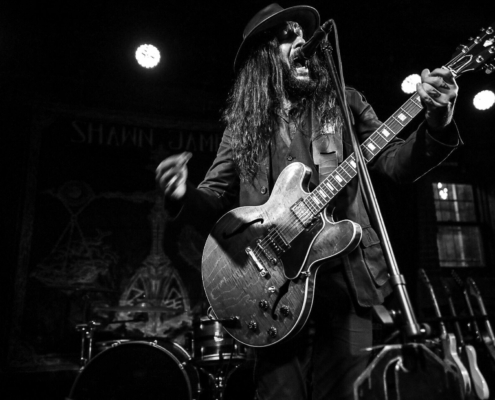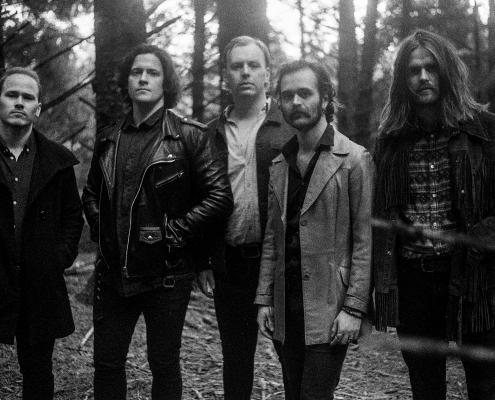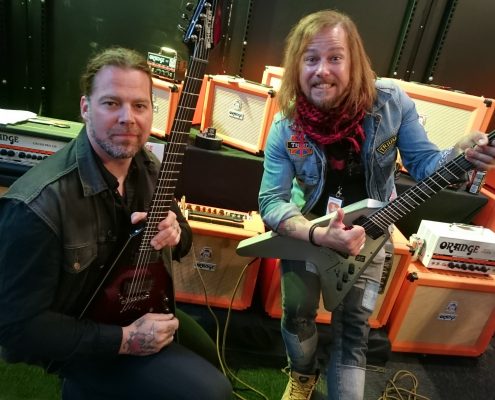Jim Root of Slipknot demos the Rockerverb 100 MK3 guitar amp live at Download Festival. Find our Rockerverb series here.
Tag Archive for: Rockerverb
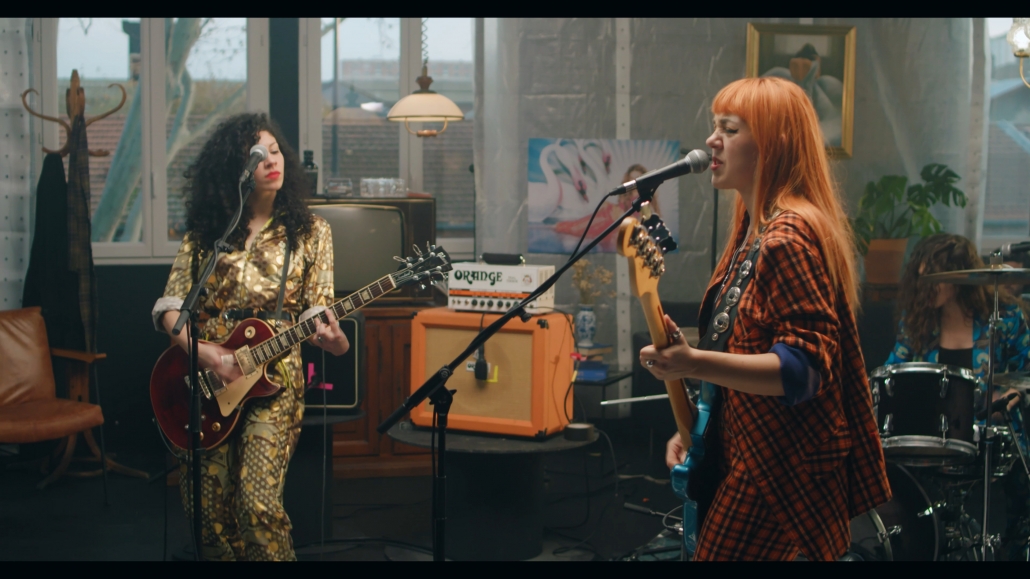
Grandma’s Ashes, can we get a bit of background on the band?
Myriam: I first met with Eva on the internet and joined her punk-rock/noise band and we played with different drummers before we eventually decided we wanted to play heavier music. We started over and found Edith online. We jammed, and her math-rock influences took us in a more progressive direction. That’s how we ended up mixing heavy riffs, progressive parts and powerful melodies. We’ve been playing together for three years now.
Are most of your songs a result of jamming, or do you work from structured ideas?
Myriam: One of us will usually come up with with a riff or melody that suits a particular emotion, then we’ll jam it around and end up with different parts that we’ll put together.
Eva: I write a lot of voice melodies when I’m at home, and often come to rehearsal with voice lines and simple bass lines, then Myriam will find something to do with it, bring heavy riffs before Edith comes with her complex rhythmics.
Are there any artists in particular that have inspired you two as players, or someone that encouraged you to pick up your instruments to begin with?
Myriam: My dad plays guitar and taught me the basics of blues with Muddy Waters and Buddy Guy when I was 9. However, it wasn’t until discovered Led Zeppelin at the age of 13 I became obsessed with the guitar. I’d say Jimmy Page, Eddie Van Halen and Matt Bellamy were my early inspirations as a teenager. I later discovered QOTSA and Frank Zappa, which inspired the tones I use with the band and the modal scales I sometimes use when I improvise.
Eva: My father was my first inspiration, he’s a multi-instrumentalist and was playing in different bands within different genres when I was growing up up, jazz, rock, punk and blues. I was surrounded by instruments as a child and he’d teach me. When I was 11, I discovered The Stranglers and was instantly very interested by the incredible J.J Burnel’s heavy, slamming but fat bass sound! I started playing bass right after that. After that I discovered Flea, and Chris Squier from Yes, both with more complicated bass lines. That paired with my growing love for funk, I started to work on my sound because I wanted to achieve a mix between two iconic styles, the incisive and punk one, and the groovy, melodic tone of my prog rock idols.
You’re releasing your first EP ‘The Fates’ in January, what can you tell us about it?Myriam: We recorded ‘The Fates’ a year ago at “Ferber”, a famous French recording studio where Zappa and Black Sabbath used to come in the 70s. We decided to record everything live with no overdubs in order to try and catch the energy of our live performances. We worked with producer Mario Caladato Jr. (The Mars Volta, Beastie Boys etc) who helped us find a balance between the aerial atmospheres of the vocals and the heavier parts.
Eva: By recording it live we managed to capture the synergy we feel between the three of us while jamming. We wanted it to be as fluid as possible, and highlight the emotional involvement in each song when played live. We named it “The Fates” after the three Moirai in Greek mythology, known as the sisters who determine the origin of the world and human beings. One is giving life, by spinning the wool, one unwinding the thread and the last one cutting it, bringing death. We loved that very symbolical allegory of our roles in the band.
What’s your history and experience with Orange?
Myriam: My first ever encounter was whenI was looking for a tube amp that could be aggressive and round at the same time, and a friend of mine let me try their TH30, the sound was both crispy and round. I’m also really into the desert rock scene, and when I saw Sleep live with Matt Pike’s wall of Rockerverbs I thought that it was the deepest guitar sound ever!
Eva: I noticed Orange Amps at festivals and I very intrigued by the colourful design, and when Myriam bought one I immediately loved its power!
Myriam, I know you play the Dual Terror, why did you go for that one and what’s your thoughts on it?
Myriam: It’s the first amp I ever bought with my very first paycheck : I needed a two channel amp because we have some ethereal parts in our music where a nice clean sound is necessary. The tiny channel of the DT has that slamming clean tone. I mainly use the fat channel with the typical Orange crunch sound and add fuzz or overdrive to it. I also went for the Dual Terror because of its practicality. It doesn’t weigh that much and is also switchable from 30w to 15w, which is really useful in the studio or in rehearsal to push the tubes without sounding too loud.
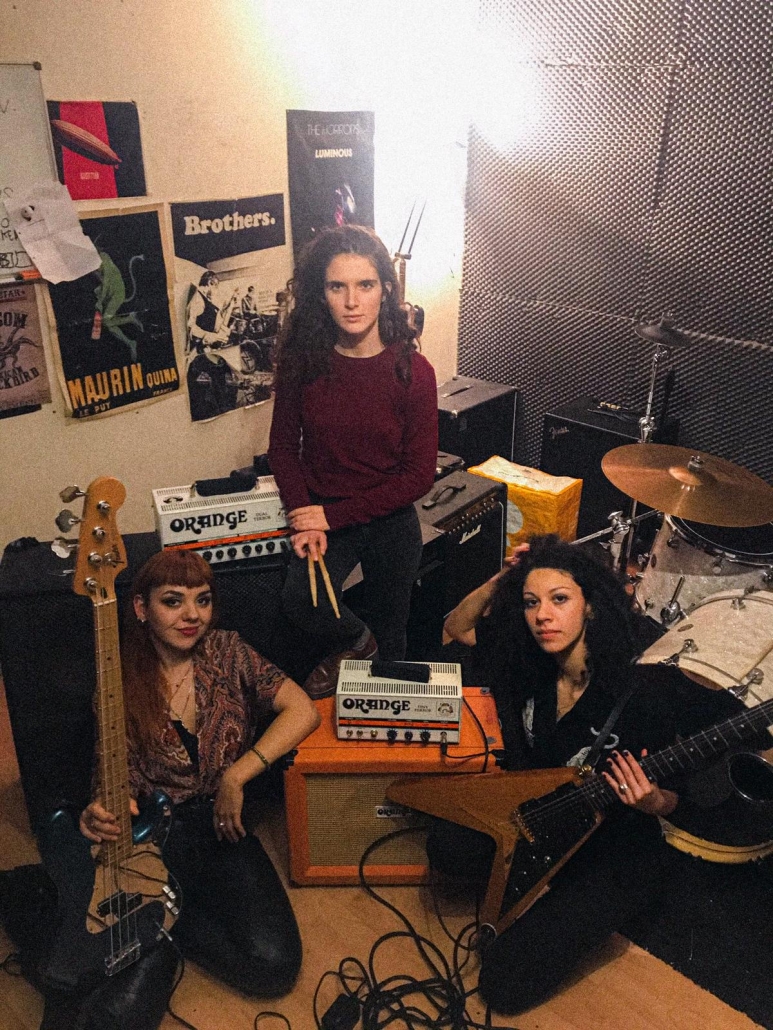
How does your dream Orange riggs / stacks look like?
Myriam: I like to play with a dry/wet setup, so my dream Orange stack would be the Orange Rockerverb 50 MKIII paired with a PPC 412. Because it has an FX loop and two separate channels, it would allow me to have cleaner modulation effects such as phaser, delays etc. than I have currently on the DT. The other amp would be a Tiny terror on a PPC 212. I like it with a crunchy sound and a really light slap delay. It also works well with fuzzs and overdrives because of its narrow frequency response.
Eva: I’d like to split my sound on two cabs, and looking for the best one to fit with my Sunn O))) Concert Bass, so I would say an OBC410, or OBC212 and OBC115 paired with a Terror Bass. I secretly dream of a AD200B, but unfortunately it’s a little heavy to bring home after rehearsal on the Parisian subway…
If you could tour with any band or artist, who would it be, and why?
Monolord! We discovered them with their last album, No Comfort. Their riffs are so heavy, it’s truly a slap in the face listening to them play live. We’d like to tour with them because we are comfortable in the stoner rock scene generally, and people look really psyched at their gigs.
Every month we reward one lucky winner with a free pair of O-Edition Headphones. All you have to do is post your Orange rig to any qualifying social media using the hashtag #OrangeRigOfTheMonth. Please note we are not accepting entries via email.
What’s your name, age, occupation?
Reno Gooch, 45, musician, actor, hemp farmer, stage hand.
How’d you first hear about Orange?
When I was a child I saw the Beat Club videos of Black Sabbath and their Orange half stacks all around. It was a turning point for me and the Orange stacks were imprinted into my psyche. Just looking at my half stack takes me back to that feeling of being so excited about music.
What do you use your rig for?
My Oranges are used for performing and recording with my psychedelic fuzz band Space Coke.
How much did this rig set you back?
6 magic beans. Seriously though, I traded something for the Terror Stamp locally. I have 4 orange rigs so to speak, the Rockerverb MKiii 50 and PPC412, I have a Micro Terror with the 1×8, a Terror Stamp and an OR15 with a PPC112. I’m happy to be getting the Orange headphones to go with the Micro and Stamp.
How often do you update the rig?
I will never update my Rockerverb MKiii. It’s the best amp ever I truly believe. I may get a second PPC412 to go with it though! I’m updating the Terror Stamp with the Headphones you’re awarding me.
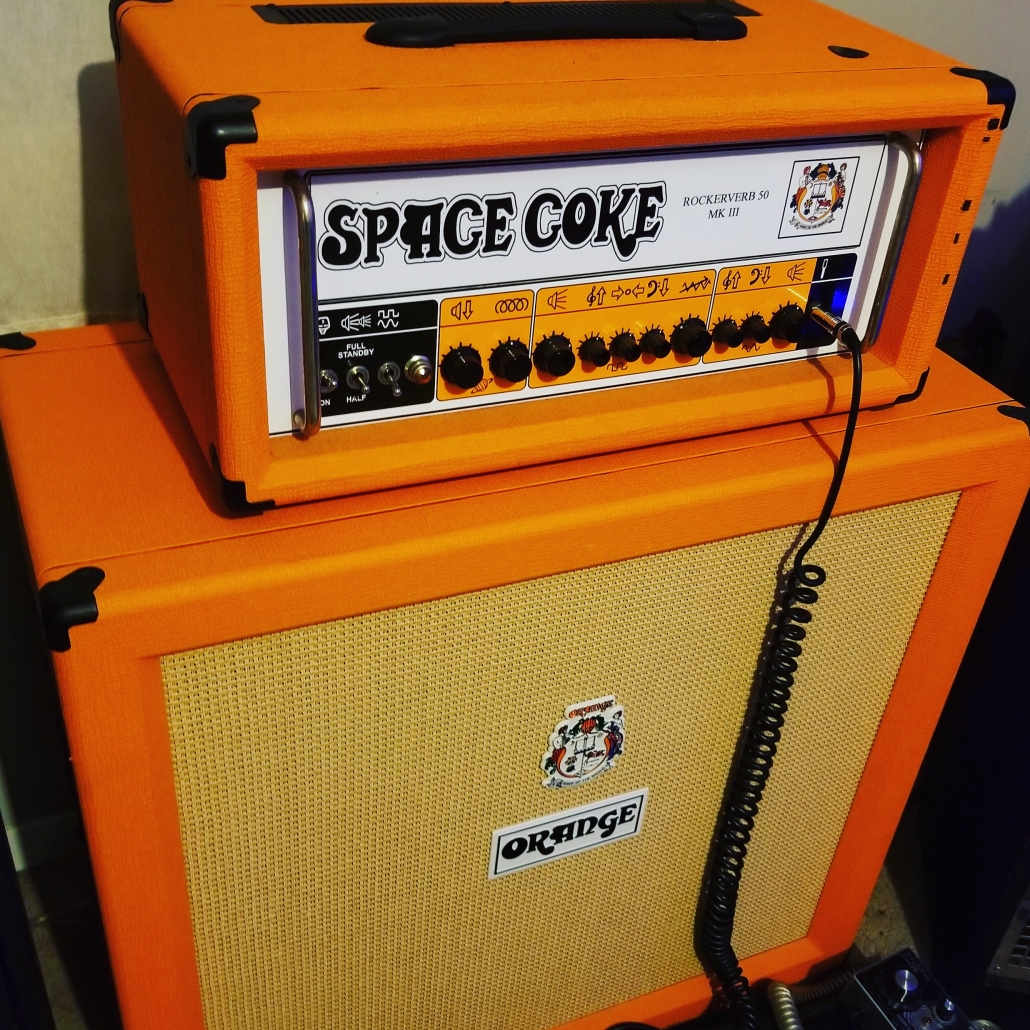
What gear is in this rig?
For my rig of the month it’s a Terror Stamp alongside my Seeker Effects Iommi styled Rangemaster. The tube preamp let’s me use my gig pedals and listen with headphones (which I now will have thanks to the generous Orange team!)
What guitar do you use? Why?
I have 2 Gibson SGs. A white limited edition with Seymour Duncan Whole Lotta Humbuckers. It sounds amazing and has a thicker neck. Its name is Nuit Ma Ahathoor Hecate Sappho Jezebel Lilith Crowley aka “the white witch.” My other is a black Traditional with stock ’61 pickups. It’s a lefty. I’m lefty but play righty. I like using flipped lefty’s because it puts the controls where I like em. I use SGs because of my heroes Iommi and Sister Rosetta Tharpe.
When was the first time you saw an Orange amp?
The Black Sabbath Beat Club videos. Shortly after that Stevie Wonder live in the 70s. Stevie’s whole band had Oranges everywhere. Man that tells you it ain’t just the looks!
If you could own any piece of gear, old or new, what would it be and why?
That’s a very tough question! I’m gonna pick Sister Rosetta’s 3 pickup white SG.
Who is your guitar hero?
Another impossible question! I’m taking the liberty of saying my main influences all together Helios Creed, Paul Leary, Iommi, Zappa and Hendrix.
Can you share any links where people can go to hear how this sounds?
Spacecoke.bandcamp.com. The Terror Stamp in particular will be on our upcoming LP on Forbidden Place Records. Out early 2021. I will also be posting videos soon on our Instagram page.
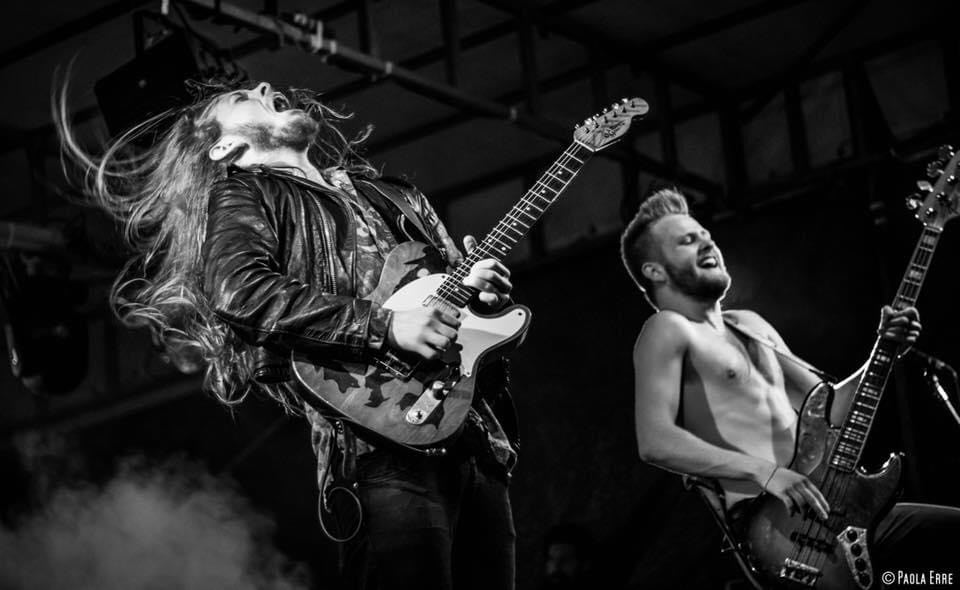
This year at Black Deer Festival Orange got the pleasure to sit down with Oskar and Alex from Icelandic rock band Vintage Caravan. The band had just played a set at the festival and chatted about their Orange rigs, the Rockerverb MKIII and the Terror Bass, we also found out about their influences and how Icelandic culture and weather helps to galvanise a band.
Oskar: Hi my name is Óskar Logi Ágústsson, I play guitar and I sing.
Alex: Hi i’m Alex and I play bass.
What inspired you to start playing music?
Alex: I remember starting to listen to ‘Rage Against the Machine’ and thinking that guy sounds pretty fuckin’ bad ass. That kind of propelled me into playing bass and stuff like that, really got the juices flowing!
Oskar: Ugh! I started playing guitar when I was 9, I watched School of Rock and that got me thinking, if they can do it, I can do it.
Alex: I think every kid our age got inspiration from that.
Oskar: Thank you Jack Black! When I head Led Zeppelin and Jimmy Hendrix, there was no turning back.
Tell us about the music scene you grew up with?
Alex: I mean the music scene has always kind of been very strong in Iceland, it’s kind of inspiring to grow up there but also there is not that much to do. The weather is awful all of the time or most of the time.
Oskar: It’s also dark for most for most of the day in the winter time, so you have to do something.
Alex: For nerdy kids like us that meant playing bass and guitar.
When was the first time you spotted an Orange Amp?
Alex: A guy I played in a band with, when I was like 11, he had an Orange combo. I can’t remember the exact model, it was such a noticable brand as there are no other Orange coloured amps. So immediately when you see it you can’t….
Oskar: You can’t get confused with anything else! For me it was seeing Tony Iommi, Paul Kossoff, seeing Fleetwood Mac and Peter Green. Seeing those guys using it, I was associating Orange with great tone and great playing, as they were flying the Orange flag, it was very inspiring.
Tell us about your current set-up?
Alex: I’m running an 8X10 and actually I have be running almost exclusively a new Terror Bass amp. Its cool because I can fly anywhere and it sounds amazing. I’ve tried a lot of these Class D, solid state amplifiers because there is a lot of them out now. Actually I have never tried one that has a weight to the sound, like you get from a really good solid state amp or a tube amp, that you don’t really see in a lot of those other small amps.
Oskar: For me I’m getting the Rockerverb 100 MKIII.
Tell us about why you choose this particular gear?
Alex: In terms of sound I always try to go for something that can stay full and rich but is immensely punchy. Because I have to have a lot of punch all the time, I don’t know maybe i’m compensating for something. Not every amp can do that, I really like how you can turn up the gain on an Orange amp, it seems to do something funny that makes it really fat and powerful, which i don’t see in many modern amps.
Oskar: The Rockerverb just gives me the wings to fly! A cliche yes! I almost teared up myself. It makes my guitars really sing and its super tight, I don’t know really how to explain it but it has that huge body to it and it sings. There is no part of it that is floppy, it is just there and great for the mix.
How does it feel to be part of the Orange family?
Oskar: Being an ambassador of Orange is a dream come true, it’s mind blowing just being part of the huge roster.
Alex: It’s a big honour for us, for sure, we are very happy to working with you guys,
Oskar: Super happy, it’s quite surreal seeing our names on the website. I know that man!
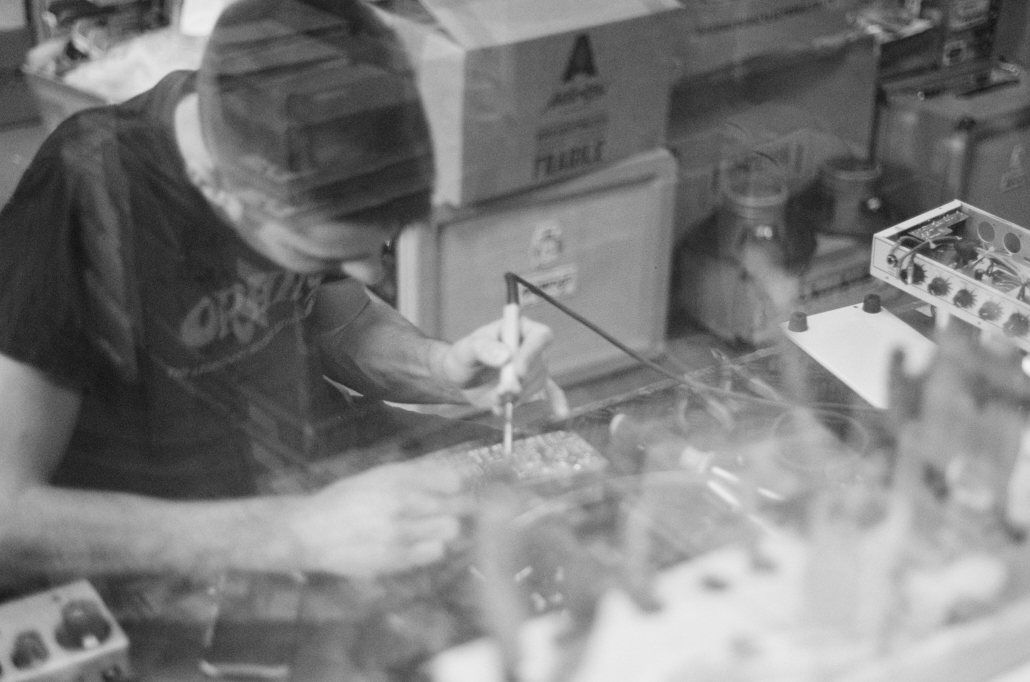
We pinned down Workshop Manager Mikko Malén and Product Demonstrator John Dines to answer some of your tech related questions. We received a whole bunch, and figured we’d do them in two parts so your eyes don’t turn square what reading. Here’s John’s answers:
Why does my TH30 make noise when effects loop is in use? Otherwise its fine.
John: The TH30’s FX Loop uses a series configuration and is always part of the circuit. Essentially, you’re always “hearing” the FX Loop even with nothing connected. This means the fault is elsewhere in your signal chain, not in the amp. Typical causes of noise in pedal signal chains are bad instrument leads/patch leads, incorrect pedal power supply specification or non-isolated grounding between power supply outlets, ground loops within the FX chain and other pedal faults. A good place to start is to check the pedals are receiving the correct power, then try connecting each one individually (do the same with your leads). Some power supply-related issues may only show up when using certain combinations of pedals, though. It’s a big rabbit hole to do down but, with some planning and structured troubleshooting, you can get to the bottom of it – and you’ll learn a lot in the process. Good luck!
Can we hear more about the process arriving at TremLord’s base tone? Been surprised at how nice the clean is yet impressed how distinct it is from other brands.
John: This is really a question for Orange Technical Director, Adrian Emsley but I’ll do my best to cover the basics. There’s actually quite a history of great clean sounds at Orange Amps. The Rockerverb, AD30 and Rocker 30 are all good examples. The Tremlord was always meant to be a bit different. Taking the bright and scooped character of the Rockerverb’s Clean channel and mixing it with an EL84 power amp and open-loop design makes for a unique non-master volume design that’s familiarly “vintage enough” for those seeking classic tones. A valve-driven reverb was a must, and a 2-spring tank was chosen (instead of the usual 3) to add to the splashy, retro vibe. As the name suggests, the real centrepiece of the amp is the all-valve bias modulation Tremolo. This kind of super-authentic circuit is usually reserved for very boutique amps so it helps to set it apart from other amps at the same price. And having two footswitchable speed controls is unheard of! Rather than make an all-out copy of a ‘50s amp (with all the problems too!), Emsley wanted to include vintage tone and features in an up-to-date amp, so footswitching for the Tremolo, Speed and Reverb was added, along with some useful output power switching options. Another modern addition is the valve-driven FX Loop. This meant taking the unusual decision to implement the Tremolo in the preamp (traditionally, Tremolo effects work in the power amp). This means that, depending how you connect your pedal chain, you can place a real, valve tremolo anywhere in your signal path. You can also drive stereo rigs with the Tremolo appearing in both channels. There you go. It was just meant to be a very Orange take on a ‘50s amp for the modern player.
I need my Engl to turn into an orange amp instead, any suggestions?
John: This is really a two-stage process. The best method is to first turn your Engl into cash. It should then be possible to turn the cash into an Orange.
Can I use my Crush 12 for my bass? If so what’s the right settings for a good warmer tone?
John: While the use of a Bass guitar will not damage the amp, you must consider a few things. Firstly, Bass requires a lot more power than guitar to be heard at the same volume (there are some solid, scientific reasons for this but I won’t go into them here), so you will likely find the Crush 12 very underpowered, even for home use. Secondly, the speaker in the Crush 12 is designed for guitar and its frequency response will not extend as low as you would expect from a Bass speaker. Lastly, the gain structure and EQ controls are optimised for guitar so it will be difficult to dial in the perfect Bass tone. You will be able to “get by” at low volumes but this is the reason we make dedicated Bass practice amps. Even the entry-level Crush Bass 25 addresses a lot of these points: It’s twice as powerful, is voiced specifically for Bass Guitar with an EQ familiar to users of pro Bass gear, and has a dedicated Bass speaker in a ported cabinet. It’s best to have the right tools for the job.
100w transistor amp. How many watts is that equivalent to for a valve amp?
John: I’ll start with the simple answer: 100W. It’s a common misconception that valve Watts and solid state Watts are different. It’s a universal measurement of power and does not discriminate. However, there are few factors that have contributed to this misconception. Firstly, valve power amps sound great when distorted whereas it’s generally considered to be the case that solid state power amps do not. Add to this that amps are rated at full clean power. An amp that is rated at 100W clean will produce 141W when the power amp is at full saturation. This will probably sound pretty good with a valve amp but not with a solid state amp. Thus, a valve amp can be thought of to have an extra 40% of “usable” power when compared to a solid state amp. Next, think about the decades over which this stereotype has formed. The older solid state amps in question were usually the “cheap option” and are more likely to have been rated somewhat generously. There is a possibility that some amps over the years, especially at the lower end of the market, have been given “downhill with the wind behind it” power ratings. Furthermore, solid state output power varies with cabinet impedance whilst valve output power doesn’t. Many of these assumptions about power could have been made when using a solid state amp that is rated at 100W @4 Ohms into a 16 Ohm cab. The amp would be producing somewhere between 30-50W in this case.
Then there’s the issue of speaker sensitivity. Again, considering that many solid state amps are designed as more affordable alternatives, a lower-spec speaker could also skew players’ perceptions. If you’re used to hearing your 100W amp through a 100dB* speaker, a 97dB speaker would suddenly make your favourite amp only sound like a 50 Watter. Higher sensitivity speakers tend to need bigger magnets. Bigger magnets cost more money (both in terms of materials and in shipping the extra weight). You see where I’m going with this. As this is an Orange blog, it’s worth noting that even Orange’s more affordable Crush Pro solid state amps use a 100dB speaker, just like the flagship valve gear. So, all things being equal (both amps running a fully clean signal into 100dB speaker of the correct impedance and rated honestly), a solid state amp will be just as loud as a valve one. Ask a bassist or PA engineer!
*speaker sensitivity is measured in dB @1 Watt @ 1 Metre
Have you ever used 6L6 tubes in a certain model amp?
John: They’ve been tried in some Orange prototypes but EL34s or EL84s tend to suit that amps better (at least in the opinion of Technical Director, Adrian Emsley – The Gentleman Genius).
What amp settings go best with an air guitar?
John: This could turn out to be quite a long-winded reply so I’ll try and breeze through it. In fact, it’s best to start with Eric Gales’s settings and use those as a barometer. It should be easy to dial in something in that vane that’ll really blow you away. No pressure!
Is an attenuator the solution for getting the best out of the Dual Terror at a reasonable volume? As the Dual Terror doesn’t have an effects loop or line out, I was wondering why do some guitar effects particularly reverb pedals do very badly with the amp, especially on the Tiny Chanel when it is in high gain output. Is it possible that I need to change the preamp tubes, or is the Dual Terror just not the right amp to put guitar effects up front?
John: The Dual Terror and the Tiny Terror on which it is based were designed with a large focus on achieving great power amp overdrive at the kind of volumes that are allowed on modern stages. This is why there are multiple output power settings – to allow the user to reach the “sweet spot” of the amp at more than one volume. However, knowing that players would need great tone at even lower volumes, these amps employ an unusual design that places the Master Volume and the Tone control after the Phase Inverter. This means you can dial in a low-volume sound that’s a lot closer to power amp saturation than you could expect from a more conventional master volume amp. What this does mean, though, is that all of the tone and mojo of the amp is created at a later point in the circuit than where you could place an effects loop. Even if one were fitted, you’d still have all the same problems as when running your time-based pedals up front – big Reverb into big Distortion just doesn’t work (and making it work would completely change and ruin the amp). Luckily, you’re on the right track with the attenuator.
A good attenuator (a reactive load is recommended and the correct impedance is essential) will allow you to solve both of your problems. Firstly, connecting an attenuator between your Dual Terror’s Speaker Output and your cab will allow you to dial in the perfect power amp overdrive tone and then turn down the volume to a more sociable level. Secondly, an attenuator that also features a Line Out will allow you to run your time-based effects cleanly in a Wet/Dry configuration (but you’ll need another amp and cab). Connect the Attenuator’s line output to the input of your Reverb and set the Reverb’s Mix control to 100% (or select Kill Dry if your pedal has this option). Connect the output to your second amp (something like the Terror Stamp’s FX Return input would be perfect). You’ll now get your dry signal through your main cab and the Reverb signal through whatever cab you connect the second amp to. This is a really professional way to run effects and will sound even better than an amp with a good FX Loop. Added bonus: in recording or live sound situations, the blend between Dry and Wet (Reverb) can be adjusted.
Can I put Pasta tubes in my amp? My old tubes broke. I heard when they begin to break in a bit it makes it sound extra crunchy.
John: It’s not recommended. Even if you wanted to, in the current global situation, it’s probably easier to find a matched quad of NOS Yellow Label Mullards.
Will putting loud stompboxes, like a fuzz, fuck up my preamp tubes in my sovtek mig60 even if I’m running it at low volumes? What if I run it hot?
John: Preamp valves have such an enormous amount of headroom when compared to the output of even the loudest pedals that you really have nothing to worry about. This is yet another reason why valve amps are great.
How does tubes produce tone?
John: Ah the age-old question. The RCA Radio Designer’s Handbook is a good place to start. Also The Valve Wizard is a very handy website for getting an understanding of this dark art.
Which od/dist/fuzz pedals stack well with Orange gain?
John: Which Drive/Fuzz pedals work best with certain amps is mainly a matter of personal taste so there is no quick answer, unfortunately. However, there are some general considerations that may help. When using an amp set clean, pretty much any distortion pedal will “work”, but it might not sound great. Typically, pedals that mimic the preamp of an amp, or create their own “sound” will be better. Some other drives and fuzzes (particularly older ones) sound strange, thin or horrible on their own but suddenly make sense when used with an already overdriven amp. Think about it: the old-school way was to distort an amp as much as possible and use a pedal to make up the extra gain, sometimes adding some character in the process. From your question, it sounds like you’re into the older approach. These days, and especially with Orange gear, there’s no shortage of gain available (read: more than anyone who doesn’t own a straightjacket could ever need), so it’s more about the tone. Typically, hard-clipping distortion pedals tend not to work as well into driven amps, especially if the pedal’s gain is set high. This combination can often “cancel out”, actually losing overall volume and pretty much removing any definition. Soft-clipping overdrive pedals work better, especially with the gain set low. These are the pedals I mentioned earlier – the ones that sound weird on their own. This type of pedal (there’s a famous green one and yellow one too) works well because they tend to roll off some bottom end – this stops the amp tone getting “flabby” or “mushy”, staying nice and “tight” instead. Used mostly as a clean boost, these pedals will push the amp further into saturation whilst the small amount of overdrive they provide, in combination with the tonal differences, will add some character and maintain some clarity, especially on low notes. Further to this, some drive pedals retain some of the clean signal too, which can help even more (there’s a gold one that does this – it’s expensive). Fuzz tends to be a bit easier to mix with driven amp sounds and will not suffer as much from the “cancelling out” effect that can happen with distortion. With fuzz, it’s really a case of picking the kind of character that works for you and balancing the gain of the pedal and amp so that it doesn’t become a wall of howling death (unless you’re into that). As far as Orange amps go, there’s a lot of gain and a very full, natural midrange. This means that clean boosts and mild overdrives can work very well, especially ones which don’t colour the tone too much (unless you want even more mids, which is also fine). The pedals Orange have developed are designed to sound good with pretty much anything, obviously including our amps. The Fur Coat Fuzz, Getaway Driver Overdrive (also works well as an “amp in a box” preamp) and the Two Stroke Boost EQ can cover pretty much all the territory I’ve mentioned but, as I’ve said, the real deciding factor is your ears. Check out the product pages and, most importantly, have fun!
What kind of tubes do I need for a tiny terror ? Brand, model, etc…
John: Orange Amps are currently finding JJ Valves to be the best option for preamp and EL84 types so that covers your amp. For other valve types (for the benefit of other readers), it may be that another brand is recommended and fairly regular testing is done to make sure that the best is always being used. It’s best to email in and check at the time you are replacing your valves in case anything has changed.
Best way to get rid of ground loop him when using Rocker 15 Terror or Jim root terror & having a pedalboard hooked with pedals in the effects loop & in front?
John: Ground loops occur in audio equipment when you are connecting together more than one piece of equipment which is referenced to ground. In the case of an amp and pedal board, the amp should be referenced to ground and also, the pedal power supply might be (although the outputs to the pedals should be isolated, removing the possibility of a ground loop). If you are experiencing problems with hum when using your amp with external effects, there are a few possible causes. The first possible cause is that you are using a pedal power supply that is both grounded and non-isolated. This will cause a ground loop when used with your amp. If this is the case, you will need to invest in a professional quality power supply with isolated outputs to the pedals. It may also be that one or more of your pedals is not being supplied with the correct power, causing unusually noisy operation. This would also require a properly-specified power supply. You would also experience a ground loop if you were using a mains-powered effects processor (such as a 19” rack unit) in conjunction with your amp. If this is the case and the processor has a ground lift switch, use it. Note: One piece of equipment in your rig MUST be grounded in order to be safe – in this case, it’s your amp. If there is no ground lift switch, you’ll need a ground isolator. If the processor is being used in front of the amp, you’ll just need one at the output. If it’s in the FX Loop, you’ll need them at the input and output. It is also possible that you have a different fault in your pedal board that is causing hum and being mistaken for a ground loop. This could be a bad instrument lead or patch lead, a pedal that is susceptible to noise (such as a wah or fuzz) being placed too close to a power supply or another fault with a particular pedal. Lastly, I might have misinterpreted your question and you are, in fact, using both amps at once. This will definitely cause a ground loop and require some isolation. If you’ve got them hooked up the simple way (FX Send from one amp → Stereo effects → FX Returns of both amps), then you will just need a ground isolator on the second amp. If you’re using both amps’ preamps and switching between them somehow, then routing to stereo effects and back into both power amps in stereo, you will need ground isolation at every connection to the second amp.
How do I clean my pots on a combo? Got a Rocker 15 with crackly pots on both channels. Awesome amp though – the dirty channel is everything I want in an amp. Make a 50W head with just that channel please.
John: There could be a few causes of scratchy pots. It could either be that they are dirty (and could be cleaned) or that they are worn out (and would need to be replaced). To be honest, either of those is quite unlikely in a new amp. It could also be that the preamp valves are worn. As valves wear, they can become susceptible to a phenomenon called Grid Conduction, which can cause a whooshing or scratching sound when adjusting the amp’s controls – especially the Gain and Volume. The fact that this is present on both channels makes me suspect that this is the problem. The only shared valve in the first ECC83, which handles the first stage of both channels. The other problems I’ve mentioned would likely be confined to one channel. There could also be a problem with grounding or a faulty capacitor, but this is also unlikely in such a new and well-designed amp. In any case, you should refer the repair to a good repair technician or, if your amp is still in warranty, contact your dealer. As for the 50W suggestion, I’ll pass that on to Orange’s Technical Director, Adrian Emsley but I think the Custom Shop 50 will suit your needs very well and I expect him to say the same.
Can I run the Terror Stamp on 18v or will it explode?
John: You cannot run the Terror Stamp from an 18V supply. It requires a 15VDC 2.1mm centre positive power supply and is supplied with one. The product page will soon be updated with a figure for current draw so that users can specify their own power supply for use on pedal boards.
TH30 paired with a Jim Root PPC212, what results can you expect from those?
John: This will be a very good combination. The closed back Jim Root PPC212 will be tighter sounding and a little more resonant than the usual PPC212 Open Back. I suspect this difference will particularly suit the TH30’s Dirty channel when used for heavier styles.
A couple of months ago I went Orange and got a PPC212 AND a Dual Terror, I’m thrilled and happy, but at some point in the future I’d like to change the Dual Terror but not my cabinet. Which amp head do you recommend to go along my PPC 212 which is more powerfull than my 30 watts Dual?
John: There are a few options from the Orange range that would be a good upgrade from the Dual Terror (not that there’s anything wrong with that amp). If you really like the old-school Orange tone of the Dual Terror but could live with only one channel, the Custom Shop 50 absolutely nails the vintage Orange sound. The Class AB/Class A switch and Point-to-Point construction are also really cool features. If you like having two of the same channel but need a more powerful amp, the Dual Dark is the one for you. The channels are higher-gain than the Dual Terror but will both clean right up if you want them too. Obviously there’s the Rockerverb. It’s the choice for anyone who wants versatility and high power. And Reverb too! Any of these will pair nicely with the PPC212.
Can I run the terror stamp into a combo amp and get a “clean” tone ?
John: This is best answered in two parts:
1. The Terror Stamp can be used for clean sounds all the way up to heavy-enough-for-most-styles.
2. The Terror Stamp can be used as a pedal/preamp in front of a normal amp. Just connect the FX Send of the Stamp to the input of your amp. This will allow you to use all the sounds available from the Terror Stamp – including the clean ones.
I’ve got an Orange Crush 20L and it’s stopped working, plug it in and the light doesn’t come on and no sound. Would it be something to do with the fuse or do I have to have a deeper look?
John: This highlights a common misconception: the fuse is not the cause of the fault – it’s the indicator of it. It sounds like the fuse has blown but this will have happened because of a more serious fault in the amp (it blows to protect the amp from further damage). Your Crush 20L will need to be referred to a good repair technician to be fixed.
Of all the genres of music, country is exceptional.
Formed by a continent of migrants, country music is a concoction of hardships and woes interlaced with the music and culture from across the globe. Its predecessor, Roots, spawned a vast array of musical styles that have since split and reconnected many times over.
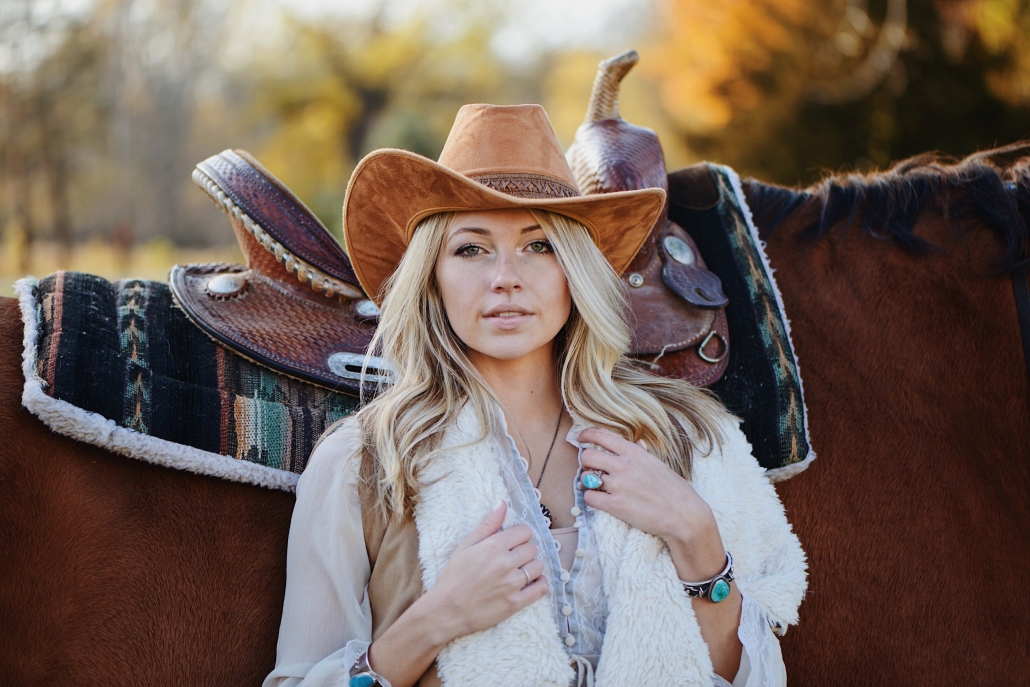
It’s music built on experimentation and where one in a million chance happenings seem to occur on a frequent basis. Swerving the direction into new unexplored areas, just as the pioneers had done way back when.
From Cash to Stretches
Although there were many country greats before Johnny Cash, the Rockabilly sound of the 50s, driven by amplified guitars, was a defining moment in the evolution of country music. Luther Perkins, ‘the original man behind the man in black’ paid a huge part in that with his signature ‘boom-chicka-boom’ sound which defined the genre.
It is said that Perkins’ style of playing came by chance when defective equipment left him little choice but to dampen his strings with his palm. Consider the classic locomotive stomp from the hit song ‘Fulsom Prison Blues’. To pull that off requires skill and equipment capable of bringing out those tonal nuances.
A Modern Twist on an Old Faithful
The Orange TremLord 30 was designed with careful consideration to players needs, offering a compact 30-watt all-valve combo that replicates the golden age of Country tone. It’s a sweet sounding amp with an Orange twist, featuring those classic EL84 tubes that add a little British character to the mids.
What makes this amp unique is the custom made Lavoce 1×12” speaker providing a smoother top end along with more headroom before the amp starts breaking up. It’s the perfect match for players looking for responsiveness; faithfully replicating the subtlety and spacious voicing of that golden age.
Eloquent clean tones can be ceremoniously battered by a crashy, splashy beast of a tube driven two-spring reverb tank that oozes with vintage class. If you want to add in delays or compression for a truly authentic sound, the low impedance 12AT7 tube driven FX loop gives you flexibility without sacrificing on tone. Even at lower volumes, Tremlord 30 is designed to be switched all the way to 1-Watt, ideal for even the most intimate spaces.
The Bakersfield Sound
Speaking of intimate spaces, it was Mearle Haggard experience of watching Jonny Cash perform at San Quentin State Prison in 1959 that lead him to pursue his calling in country music. As far as country players go, Haggard is what Joe Strummer was to Punk Rock; he provided a stark contrast to heavily producer controlled music that choked the mainstream airwaves.
The music was called the Bakersfield sound and its reverberations have cut deep into the music of America, influencing the artists like the Grateful Dead, Credence Clearwater Revival and The Flying Burrito Brothers. These artists, in turn, influenced the Southern Rock movement, and at its peak in the 70s, guitarists began to turn to the grunt of an all-tube British amplifier.
Our flagship Orange AD30 is an ideal midpoint between the classic country tone and that synonymous British sound that harks back to the heyday of the all-valve amplifier. Its balanced and natural compression is the perfect all-rounder amp for country picking. If you need more heat, the second channel gives you more attack while still emphasising the bottom end for a full-bodied tone.
A Divided Country
On one side of the ravine, a glassy formation looms ominously; its meteoric rise is a paragon of success and excess. Below, overshadowed by the enormity of its neighbour, a gritty cliff edge juts out over the ravine.
And there’s no way better to explain it, mainstream traditional and pop country guitarists usually opt for the open and glassy chimes of an amplifier with those iconic American 6V6 tubes. It’s a path well trodden.
Artists like Tim Montana and The Shrednecks aren’t just pushing the envelope of sound, they’re pioneering a new wave of southern rock that’s like a sonic punch in the face. The bastard love child of ZZ Top where smashing out riffs like Thor’s hammer on the Rockies is just another day in the trailer park. Their weapon of choice is the Rockerverb MKiii.
This boozed-up, steroid-fuelled monster is no roadhouse frequenter. It’s built for a hardcore workout on the road with a feast of total delights that range from chimey cleans and iconic gain tones of a classic British crunch right through to a fistfight with Satan himself.
But others choose to expand the frontiers.
Looking Back to Go Forward
Not so long ago the general public could distinguish the difference between that classic American tone and the British sound. While they are fundamentally different, the lines have become blurred. That’s when the magic happens.
Take modern country artist Claudia Hoyser, her amp of choice is the Rocker 15. It’s an amp that is perfectly voiced to bring out the natural sound of the instrument, the perfect accompaniment for Hoyser’s sultry vocal styling. Sensitive to the touch of dynamics and oozing with valve warmth the Rocker 15 begs one question.
How long before others walk the line?
Corey: After being a band for a few years, when James, Andrew and I sat down to start writing music the stuff we were coming up with was just more of a punk influence. All of us have been huge punk fans since we were all younger so it was kind of a natural progression and kind of just go back to that. But we still also kept a lot of the heavy end stuff in.
Scary: I just joined the band after this record came out because they did a lot of second guitar stuff and they wanted to do it live. I’ve been friends with the band since they started, I did pre production for a lot of the older records, ‘taste of sin’, ‘set the dial.’ I would go to their space and record it and then send it off to their engineer that were actually going to produce the record. So i’ve known the band for a long time and they asked me to play after the record was done and i’ve been playing in cover bands with Andrew and James since i moved to Savannah so it’s been fun, i’ve known the guys for a long time.
Corey: So we we’ve been working with the company maybe two years but prior to that i’ve used a lot of Orange stuff when we would come to Europe and we would rent a backline. The bass stuff was generally an Orange and that’s what started my interest in using the amps.
Scary: I started using the Orange back in 2009 or 2010, I got the Rockerverb MKI and i bought it because I had seen so many great bands using it. I bought it on a whim and its been my tone ever since, in history!! I’ve had the Rockerverb MKI, MKII, MKIII and they just keep getting better, the MKIII is just awesome, I love it!
Corey: NERD!
Scary: I know! The stepped attenuators are fantastic!!
Corey: I like with bass something that has some kind of drive section and that is not just a clean, I definitely like tube and bit of a lower wattage than the big SVT type things, 200 is quite a good match. You can push the amp a bit more and retain a lot of that good EQ sound without turning it to one of five.
Scarey: Overdrive and the preamp section is really big for me because its like there are a lot of amps that have really good overdrive but then they sound a little fizzy. The gain on the Rockerverb has always been really nice in my ear and the reverb on the new MKIII’s are amazing, totally usable and then the clean is amazing for pushing pedals. The overdrive though has been something that has won me over for years, haven’t been able to find something like that, for something that fits my ear in years.
Corey: I have the AD200 and also the Two Stroke pedal and the OB1 as my backup amplifier. I’m using the Two Stroke as more of an overdrive pedal, not throughout the entire set or song. I always like a more treble sound like the old Jesus Lizard stuff, that kind of stuff has to have the midrange boost to kind of overdrive the amp nicely.
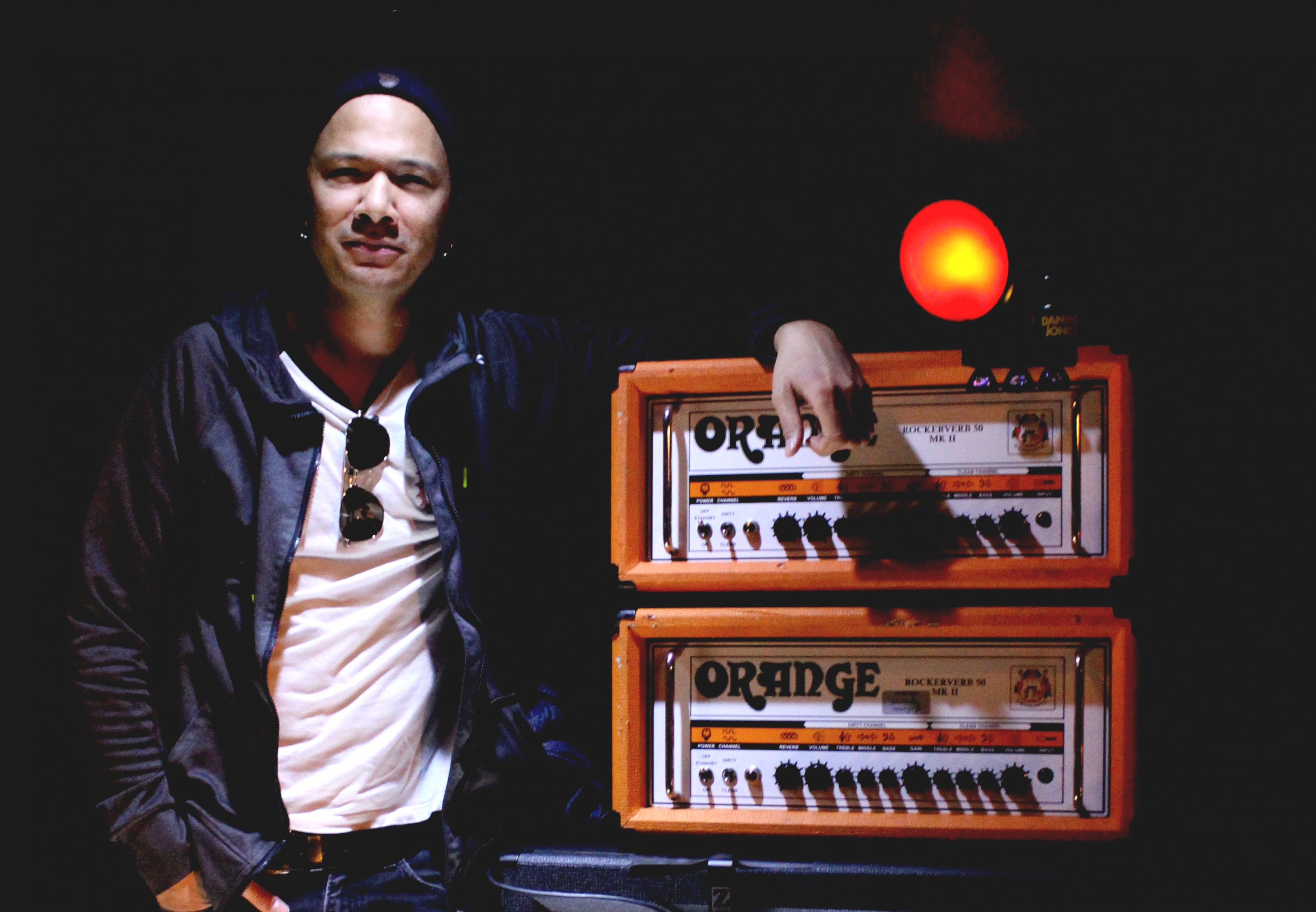 Let’s dive right in and talk about your history with Orange – do your remember your first ever encounter with the brand, whether it was playing it yourself or seeing someone else play one?
Let’s dive right in and talk about your history with Orange – do your remember your first ever encounter with the brand, whether it was playing it yourself or seeing someone else play one?
Danko: Yeah I totally remember, and the reason is why I play Orange. We went on tour with The Supersuckers, and the only way we could do that was if we could use their gear, and I used Ron’s Orange head, and I remember thinking “Holy fuck, this is just the best head I’ve ever played!”. That’s how I started with Orange, before that I’d seen other use it and I’d always liked it, but I was playing a variety of amps so it wasn’t until playing through Ron’s that Orange was really put on the map for me. When I then got the opportunity to work with Orange myself that just made sense.
You guys are known for touring relentle-
Danko: I mean – yes, yes we do, or at least have done that, and I guess we’ve been on the road a fair bit this year as well even though for me it feels like an off year. We opened up for Skindred in the UK at the start of the year, came back for festivals, made an album, and now we’re here again. The off years are always the year we make the albums, although looking back at it now it doesn’t really take us much off the road at all.
When constantly on the road, how does a day in the life of Danko Jones normally look like?
Danko: You know, not that exciting to be honest. On a day like today, I pretty much just hang around near the venue. I need sleep for my voice, so that’s about it, lots of down time. The best thing is to not think about it too much, and especially when it comes to playing the show; the moment I start thinking about things, I fuck it up on stage. There’s also this banter between the band and the audience that you just can’t plan, I’ve seen bands do that, script their set – and whenever someone shouts something at them from the crowd, they have no reply and there’s just no way of bouncing back form it. Have the songs rehearsed and that’s it, whatever happens happens. The best thing to do most days is to just go at it with a blank head and brain. So many bands these days have backing tracks and vocals and everything just seems so pre-programmed that there’s little room for spontaneity, and I think the audience picks up on that. I don’t mind if the show goes off the track, cause at least it shows the audience that they’re getting whatever we can serve them on the night, and there is something to be said for that. We go out there pretty low key, play the songs, and see where they take us.
You mentioned off years are album years, do you still write when you’re on the road or do you save that for when you’re back at home?
Danko: No, we allow enough time at home to do the writing then. We spent some time this time last year as well as before and after summer digging deep into writing, and with those sort of writing sessions we were able to figure out what we wanted, and pick 11 or 12 favourites to go on the album. Ever since Rich Knox (drums) joined the band, I haven’t felt nervous before any of the releases, more than anything I’ve been excited and impatient for people to hear what we have been working on, which means I’m confident about the songs. This album we’re due to release is another one of those. I’ll admit there’s been some albums previously where I’ve been slightly nervous whether people would like it or not, and whenever I’ve had those sorts of doubts, those are always the albums that have had mixed reviews. I’ve always liked it, but it might not appeal to everyone else. The last two albums we put out, Fire Music (2015) and Wild Cat (2017) I wasn’t even nervous, and the reviews were really good, and our new album is just as good as both of them, if not better.

To dive back into Orange for this last question, what’s your setup for tonight?
Danko: I’ve got a Rockerverb 50 head, and you know what, I’m not a gear head, I’m a creature of habit – whatever I find and like, that’s what I stick with. I can’t give you any specks of what it is I like about the head, it just have to sound like this (makes riff noise), which is a sound I’ve been making since I was seven. If it sounds like that, great. I don’t go searching for new products, and usually if I switch to something else or try something new, that will have to be presented and put in front of me. To me, amps aren’t precious possessions or collectables, they are the tools of my trade, the tools I need to do my job, and I gotta be honest, Orange is the best tools I’ve ever used.
The Dual Dark, as Lead Designer Ade Emsley describes it, is an Orange amp “for guitarists who don’t usually play Orange amps.” The Dual Dark is a completely different beast, both in terms of gain and voicing, from every other amp Orange has ever produced. It’s tighter on the bottom-end and has an almost percussive nature to its attack. And while all Orange amps tend to have massive amounts of distortion, it’s the searing brutality of the dirty channel (Channel B) on the Dual Dark really sets it apart from amps like the Rockerverb MKIII.
There are a lot of similarities between the Dual Dark and our now discontinued Thunderverb series. The Thunderverb 50 and 100 were the first Orange amps to feature attenuators and shape knobs. The attenuator is great for the studio and bedroom practice, since it allows the volume to be decreased without affecting the tone. The shape knob is actually a mid-scoop that takes the player from classic rock all the way through to mind-melting metal. These features, when introduced originally, were received well by Orange enthusiasts so it only made sense to keep them on future models (the Rockerverb MKIII also has an attenuator).
The similarities end when it comes to the voicing of the amps. If the Thunderverb was a true modern Orange amp, and the Rockerverb MKIII a melding of classic and modern tones, then the Dual Dark is the amp that bridges them all together. Channel A on the Dual Dark is extremely versatility, boasting a wide range of tones from Brit-rock to R&B. On this channel it can even be made to sound similar to our flagship AD30 head. But switch over to Channel B, the assumed “dirty channel” for most players, and let the shape knob rocket you into Thunderverb 200 high-gain metal territory (this, for example, is the channel Matt Pike from Sleep prefers).
It’s the Dual Dark’s voicing is what allows for such versatility. By backing off on the “fuzziness” that is inherent in most Orange amps (a desirable trait to most of our fans), Lead Designer Ade Emsley has made the Dual Dark capable of mimicking a wider variety of amp voicings. If other amp companies make “fizzy” sounding amps, and Orange is normally known for “fuzz,” then the Dual Dark occupies that in-between “fizz-fuzz” that makes it so unique.
There’s something for everybody in the Dual Dark series. Here are some examples of Orange Ambassadors from a wide variety of genres that have made the Dual Dark their go-to amps.
Matt Pike – Sleep, High on Fire
The Dual Dark 100 is always the first amp Matt requests on his backline riders. He prefers it above all other current production Orange amps. For him, it’s the gain and the gain alone that he desires. If we could supply him with 50 Dual Dark 100’s per show he’d take it.
After Matt Pike started using the Dual Dark 100 regularly, Al got in touch and said he was interested in giving it a shot. Al uses a huge stack of bass amps, yes, but he also runs his signal through a guitar half stack to achieve a more grindy, trebly top-end to his tone. The Dual Dark 50 has become his go-to guitar amp since 2017.
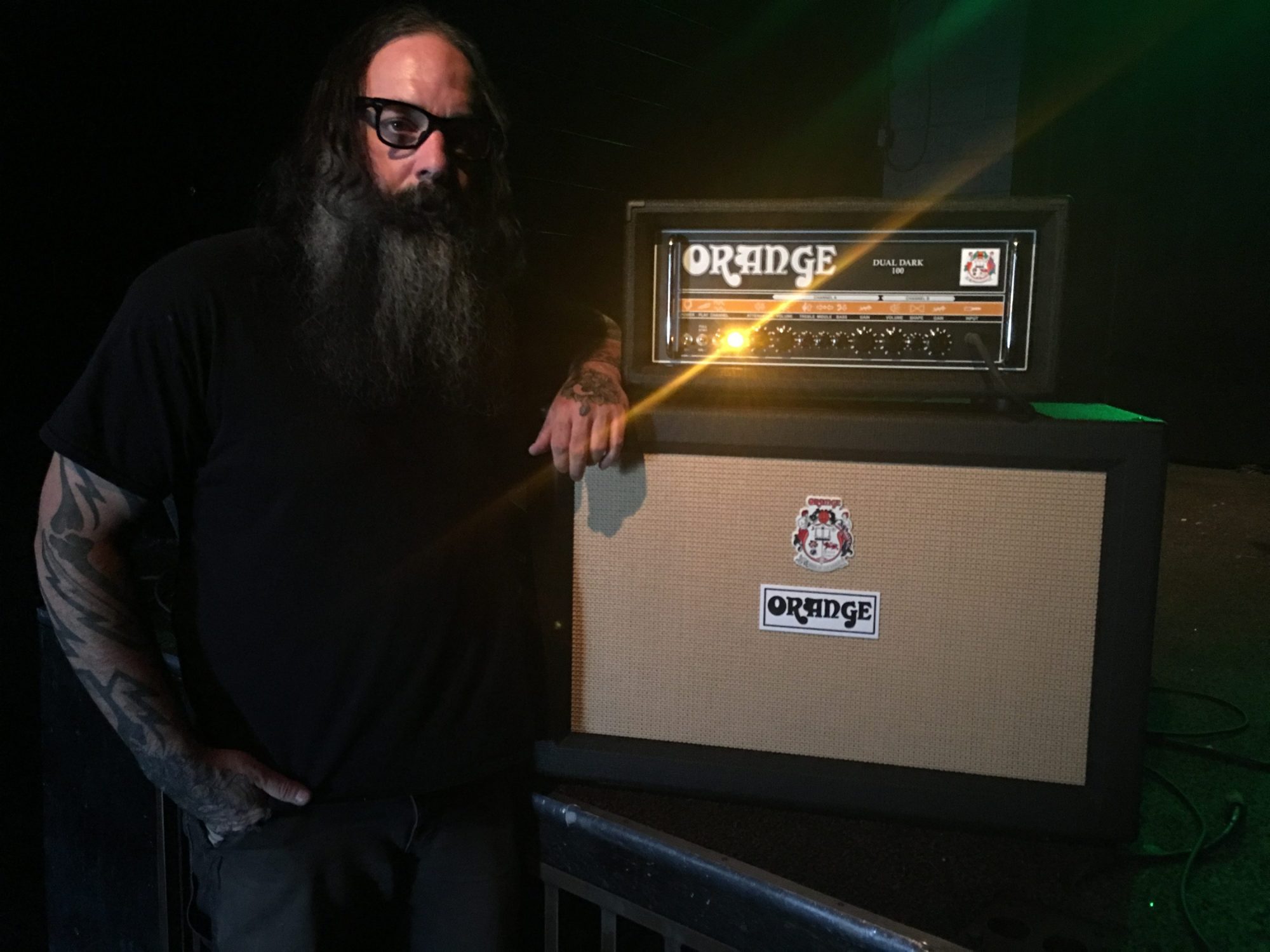
Graham Whitford – Tyler Bryant and the Shakedown
“It’s one of those amps you can plug straight into without a single pedal and get everything you need. I love it.”
Dave Catching – Eagles of Death Metal
We’ve had EODM’s lead guitarist, the absolutely most awesome dude on earth, Dave Catching, playing the Dual Darks on stage for several years. Coming from a Marshall/Fender background, he like a lot of our Dual Dark Ambassadors was turned on by the fact it doesn’t sound “classically Orange.” Dave also found that the Dual Dark can works wonders in his studio, Rancho De La Luna, with bands ranging from CKY to Kurt Vile.
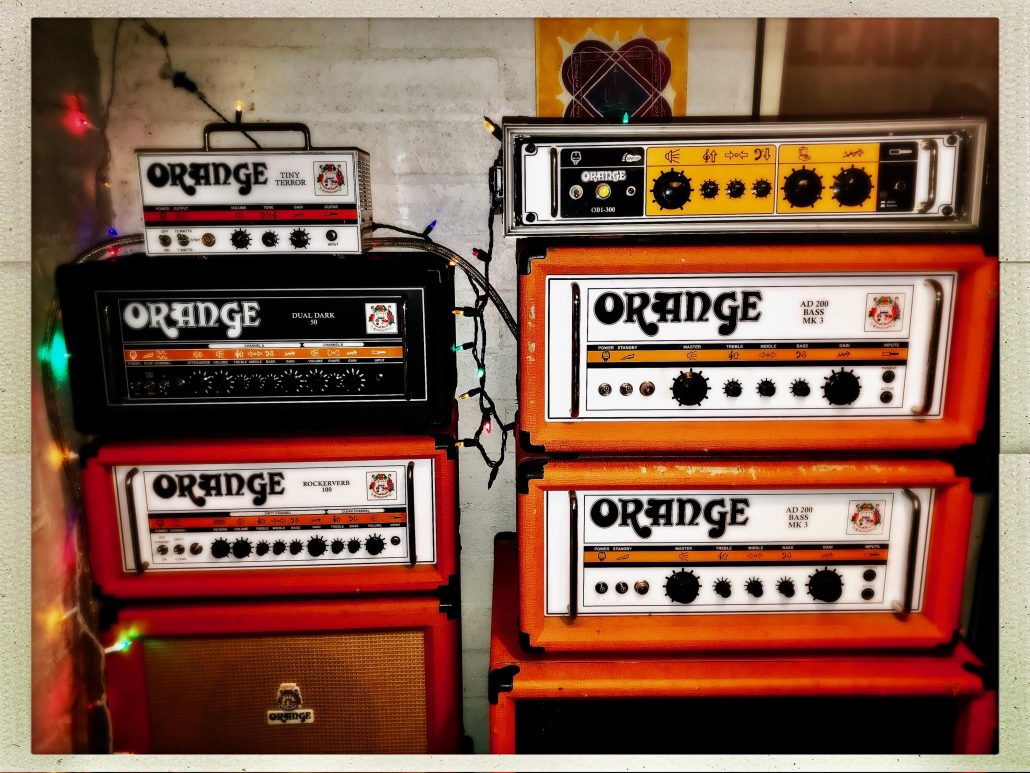
Both guitarists Davey Grahs and Nick Fuelling of Pop Evil are playing identical set-ups consisting of Dual Dark and Rockerverb 100 MKIII 100 watt heads. For their stage volume needs it’s the perfect combo. It’s a loud, LOUD rig and between both the Dual Dark and Rockerverb MKIII they’re able to recreate the full spectrum of Orange tones.
“If sounds were a person, the sound Orange produces would be the Dos Equis guy.” – Davey Grahs
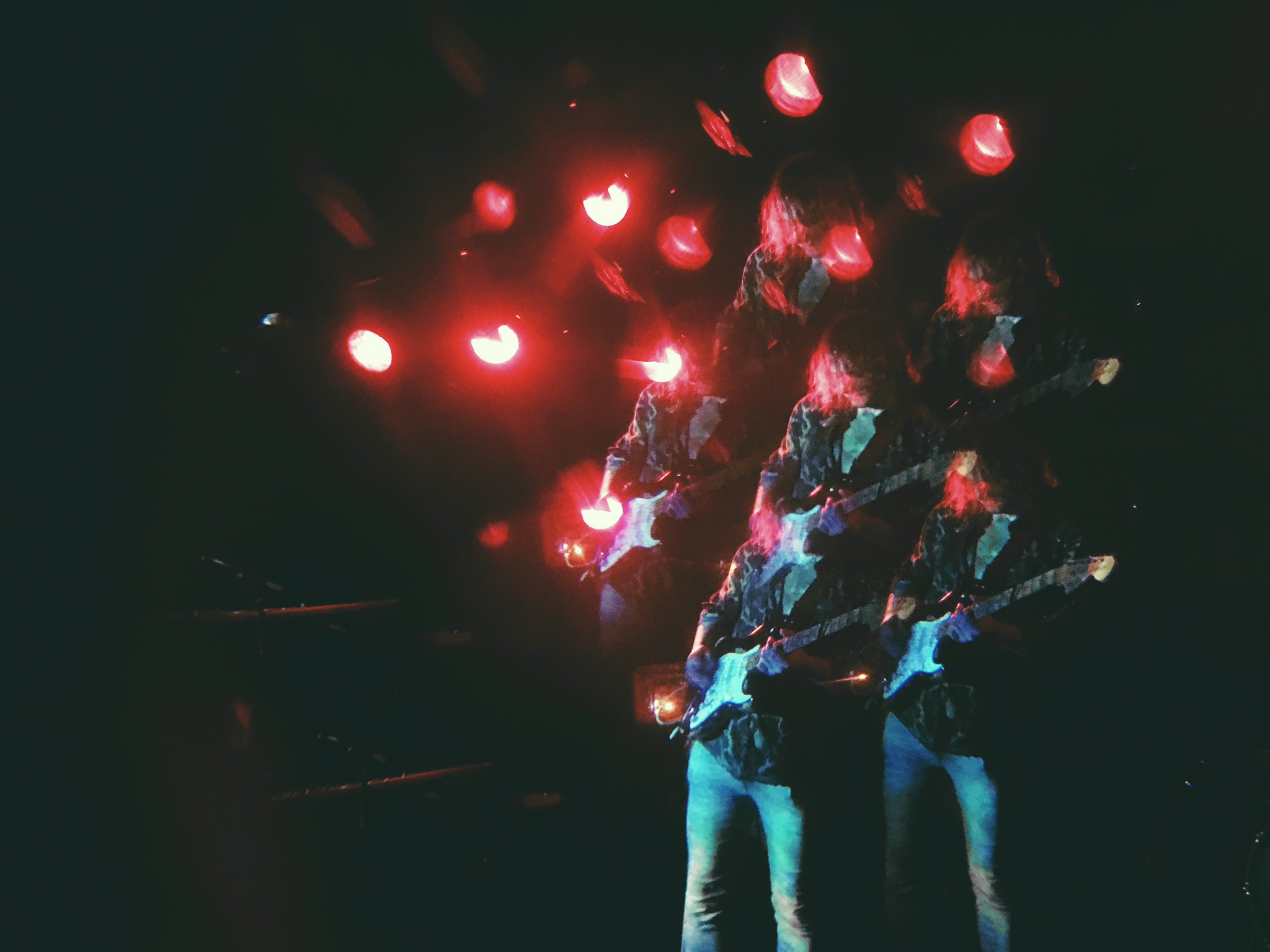
Norwegian band Shaman Elephant recently released their debut album ‘Crystals’, which the critics and music know-it-alls have been all over. Based in Bergen, one of the rainiest cities in Europe and the black metal capital of the world, I was intrigued to find out more about their trippy, feelgood psych-rock, so I decided to pin down guitarist Eirik before their release gig at Bergen’s legendary music venue Garage.
So, Eirik, fellow Norwegian viking, new record – tell us about it!
We started recording it about a year ago and did almost all of it at Bergen Kjøtt (Translates to ‘Bergen Meat’, and old factory converted into music studios and rehearsal spaces), except for vocals and overdubs which we did at Solslottet. It’s been out just over a month now and people seem to really like it! Niché magazines and music blogs have been giving it pretty good reviews, and BT (Norwegian newspaper) gave us 5/6 which we’re pretty damned pleased with. The only one who didn’t like it was Gaffa, but they can go fuck themselves.
Fair dos – clearly Gaffa knows fuck all.
How long have you guys been playing together?
The three other guys, Ole, Jard and Jonas have been in various bands together for years, but I’d say Shaman Elephant’s been going for about three.
You’ve got a big night tonight with the record release show – how’s the next couple of months looking?
We’re heading overseas to London in April, where we’ll be playing a headline show at The Unicorn with GNOB 18th of April, followed by a set at The Jonesing Jams at 93 Feet East two days later. Besides that, I reckon most of our gigs will be in Norway, possibly some German dates.
…damn, I’m really fucking hungover. Went to a gig last night and was only meant to have one beer, but when’s one beer ever actually been ‘just one beer’? Before you know it it’s 6am and you’re still going strong. It’s all good though, I’ll get another few beers in me and then chill out for a while before I go on stage. I’m really stoked about tonight, our bassist’s got this old Orange guitar amp which he’s running his bass through, it sounds sick!
Speaking of Orange, you’re an Orange man yourself?
Sure am! I’ve got a Rockerverb. I work in a guitar shop so I’ve tried pretty much all there is, and the Rockerverb’s just brilliant, same with Dual Terror and Tiny Terror, massive fan!
What got you into Orange in the first place?
I was looking for a new amp but didn’t quite know what I wanted, all I knew was that I didn’t want Marshall because I think they can get too complicated, and I wasn’t too keen on getting a Fender. There I was watching a Prince show and he was using Orange, which kind of just settled it for me. I decided on a Rockerverb – I’d never tried one, but I knew I needed one. It’s been six years now, and I couldn’t be happier with it, you get that filthy and fuzzy tone that you can only find in an Orange. A lot of sustain, and simply just a great sound. Plus, they’re Orange so they look fucking cool. I’d love to get two 4×12 cabs, it’d be pricey but worth it. Build my own wall of sound, like Sleep’s Matt Pike and his rigs of doom.
Growing up in rainy Bergen, what music would you be listening to?
I’m very much raised on my dad’s music. I went through a hip hop phase, which I still can appreciate today, but when my dad told me to check out Hendrix that changed everything. I remember finding ‘Purple Haze’ live from Woodstock, and it completely knocked me out. After that he’d just feed me whatever he’d be listening to, whether it was Led Zeppelin, Deep Purple or AC/DC, it was all thanks to my dad.
Bergen’s been mostly known for it’s black metal, how is the music scene when it comes to other genres? Is there room for variety?
Absolutely! There’s been a fair bit of this prog-jazz as well as a wave of retro noise/psych. I dont think there’s too many other bands like ours in Bergen though, so there’s always room for more. That said, Bergen was either black metal or pop music for a long time, but the last couple of years I’ve seen that new genres have been popping up between the two, filling the gaps out a bit more. Norway has a lot of trap and hip hop, so it’s cool when people break the norm and do their own thing, we need more of that.

